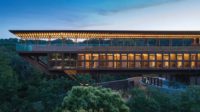Crestone, Colorado
The town of Crestone, Colorado, population 800, occupies a small swath of land on the eastern side of the remote San Luis Valley. At elevations of 8,000 feet, the valley extends 122 miles nort–south and 74 miles east–west between the Sangre de Cristo and San Juan Mountain ranges. It is among the highest and largest deserts in North America, where little more than sage, rabbitbrush, and greasewood can survive the harsh alpine conditions.
Crestone hugs the base of the Sangre de Cristos, shadowed by the 14,000-foot-high summits of Crestone Peak and Crestone Needle.
Established as a small mining town in the 1880s, Crestone emerged in the past few decades as an enclave of spiritual retreats, where a Zen center, a Carmelite monastery, a Hindu temple, and several Tibetan Buddhist centers join ranks with a host of New Age groups. Throw into that eclectic mix a handful of artists and mountain-climbing enthusiasts, and one gets a feel for the off-beat flavor of the place.
In 2005, New York City architect David Jay Weiner built a 1,200-square-foot residence on a 7-acre property in New Lebanon, New York, for a Japanese woman. This successful collaboration led, two years later, to the architect undertaking a modest retreat house in Crestone for the same client. Weiner had lived in Japan and worked for Arata Isozaki in the 1990s. He was inspired by traditional Japanese architecture, which he feels “invokes a sense of serenity and repose in connection with how a structure relates to the landscape and how interior spaces flow into each other and are oriented to specific views.” And he made sure to bring similar qualities to both the houses he designed for his Japanese client.
Called the Zen Garden House, the 1,600-square-foot Crestone residence contains three major interior spaces—a living/dining/kitchen great room, flanked by a meditation room on one side and a master bedroom suite on the other. The exterior envelope of black corrugated-metal siding folds, wraps, and bends to define the central interior space, which is vaulted on one side and has a continuous clerestory extending around three sides. “The house is conceived as if a sheet of paper had been folded and tucked around itself, almost like an origami exercise,” says Weiner. Low stucco walls extend out to the landscape to define an entry court and encircle a Zen rock garden adjacent to the meditation room. A sliding door in the meditation room establishes a strong indoor/outdoor relationship—almost bringing the Zen garden inside. Other than the garden and entry court, Weiner left the site completely untouched.
While most of Crestone’s residents live at the foot of the peaks, Weiner’s client chose a 22-acre plot of land on the valley floor, distanced enough from the mountains to offer spectacular views of them and of the Great Sand Dunes National Park, which occupies 63 acres of the valley 10 miles south. Being off-the-grid and removed from neighbors pleased the client, who wanted privacy, quiet, and a building that could be self-sustaining. The area’s 330 sun days a year ensured that a single photovoltaic panel standing outside would collect enough solar power to provide electricity for the house. Fully glazed facades on the south and southwest capture views and light, while wide overhangs protect the interior spaces from the heat of the day. Water comes from a well that accesses an aquifer—one of the largest in North America—of mineral-rich water that runs under the valley, sustaining not only this residence but the sparse population here, and the several hot-spring resorts in the area. The floor is a finished concrete slab with radiant heating, and an efficient on-demand water-heating system adds to a variety of sustainable features, such as low-VOC paints and high R-value insulation.
The house’s sleek lines and spare interior spaces make a unique contribution to Crestone’s funky eco-architecture of geodesic domes, earthships, and mountain-lodgelike dwellings. The materiality of the building breaks with tradition, too. Weiner found a kindred spirit in Keith Teahen of Teahen Construction, whose five years in Crestone taught him that the dryness and daily extreme temperature changes at this altitude cause “wood to shrink and adobe to peel.” So far, the choice of metal and stucco for the house’s exterior has proved extremely durable, says Teahen.
The Zen Garden House seems to wait patiently in its valley setting, changing with the light, anticipating the return of its owner, who travels much of the year. Humbled by the force of nature, which takes center stage here, the house coexists modestly with the wide-open sky above it, the mountains encircling it, and the valley that accommodates it.




